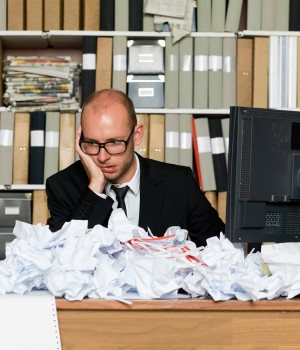The focus on big picture thinking and setting and hitting targets is a priority for many business owners, which means the attention given to environments where you work can be limited.
What’s not often considered is that decluttering, organising and styling an office can help facilitate greater clarity for everyone in the business, while reinforcing individual and team productivity.
To help business owners easily create a positive, clutter-free working environment, Officeworks has teamed up with Professional Organiser and Declutter Expert, Georgie Rees of Clutterfly, to provide practical tips.
A psychologist and Founder of The Positivity Institute, Dr Suzy Green has also contributed her insights to help businesses understand the psychological benefits of these tips.
 1. Start by thinking big!
1. Start by thinking big!
Just as you have aspirations, goals and ideal outcomes for your business, you need to apply these same objectives to your office space.
Think about the kind of mood you would like to set through colour schemes and designs, and what are the key areas that you would like to improve. This will help give you clarity and provide you with a clear direction to start your overhaul.
Dr. Green says that it’s important to create an office space that supports individual, team and business well-being and productivity.
Try to give your team members as much autonomy over creating/designing their workspace as possible. Research tells us that when people have higher levels of independence at work they report higher levels of well-being and happiness.
2. Get the order right
According to Dr. Green, there’s significant research to highlight the benefits of an ordered and decluttered environment. Clutter can have a negative impact on sustained attention – a high level of visual stimuli in our environment is naturally going to compete for our attention, meaning it can be difficult to get what we need and quick.
As with any task, you need to do things in an orderly manner to achieve the best results. Start by decluttering your space, getting rid of any obvious excess papers, files and folders on desks and around the office.
Once complete, organise what’s left. When your work environment has some structure it will become a much easier and enjoyable place to work. Lastly, and most importantly, maintain this new organised structure you have created.
3. Systems are your friend
Even if it’s just you and your laptop, every workspace needs structure. This stops the buildup of excess ‘stuff’. Whether it is paper piles or files on the computer, taking the time to create an organised filing system means that access will become so much easier, while saving you valuable time and mental energy.
It also creates a better working environment for members of your team, as everyone knows where certain documents live. Remember to create synergy between your filing systems by keeping the same folder structure and naming method.
For your paper documents, filers for desktops and key office areas are a great organisational tool.
4. Encourage empty space and group items
Leaving ‘empty space’ in a working environment is a good thing. Don’t be tempted to fill a shelf or cover a clear table with magazines for the sake of it.
When things are clear and spaced out you have the clarity to find things more easily. Take this concept a step further and group all related things together, so there’s only one place where these items can be.
 It could be as simple as putting printer supplies and paper next to the printer – you could keep an open ream of paper in an in-tray for ease when the printer runs out of paper. You will be surprised how much time this can save.
It could be as simple as putting printer supplies and paper next to the printer – you could keep an open ream of paper in an in-tray for ease when the printer runs out of paper. You will be surprised how much time this can save.
Dr. Green adds to this saying that physical space helps provide you with much needed mental space. Clear and decluttered space allows for greater levels of attentional control, so grouping items or having a place for everything will allow for greater levels of productivity and efficiency.
5. Focus on your vertical space
Walls are often not utilised in offices, but they provide a brilliant opportunity to add colour and additional storage. If you have a free wall, why not use paint to transform the area.
Depending on your overall theme, a pop of colour may be great for visiting clients or creative thinking and a calming pastel tone could be what you need to promote productivity. Utilise this wall further by installing a simple document sorter, a great tool for categorising paperwork.
To keep things from cluttering up your desktop, consider adding some drawers underneath – to be extra organised, why not label each draw.
“Utilise your spare wall by installing a vision or wipe board for your team. People can pin inspiring images, quotes or ideas to act as visual triggers or thought-starters for reaching individual, team and organisational goals,” Dr. Green says.
6. Personalise and feel inspired
Feeling neat and tidy helps give you the focus to do your best work, but you also need to feel inspired. If you’ve chosen a certain theme, pattern or colour scheme, ensure you tie in soft furnishings and office essentials throughout.
If you’ve chosen a monochrome theme, choose black and white stationery to complement this look. These additional touches will help make you feel inspired to create wonderful work, plus will add a point of difference to your office space for clients or visitors.
Dr. Green says that dependent on how much autonomy you have to design/change your workspace, consider it as an opportunity to either leverage or develop the character strength of “Appreciation of Beauty & Excellence”.
7. Recycle
Having a collection point set aside for different types of office waste is important when organising your office. Purchase distinct bins or in-trays to house near the printer for recycled or shredded paper.
When that is full, move it to an allocated place out of the main traffic area of the office. You will easily be able to see what needs to be disposed of and can plan when and where to do it i.e. e-waste, sensitive documents, or general recycling.
You can safely dispose of old batteries, phones, computers, toner and ink cartridges at your local Officeworks for free.
8. Don’t stop there
The old phrase ‘finish what you started’ rings true in an office environment. Keep your newly organised office in check by unpacking equipment after use, like files, projectors or laptops after a big presentation.
These items will then be in place for the next time you need them and won’t clutter up your office for weeks after. To give yourself a little leeway, why not allocate one area of the office where things are in an ‘organised mess’ – after all, most feel that creativity needs space and sometimes you need to leave things unfinished.
Try to limit it to one project at time so the area doesn’t become too messy. For projects, why not try a simple trestle table that can be packed up when not needed.
9. Put it in the schedule
Setting routines in the office ensures harmony and increases productivity. Whether you prefer online or paper tools to keep on top of the ‘to do’s’, if there is a core schedule then everyone knows what they’re working towards.
If you have important weekly meetings that require refreshments or equipment, set a diary reminder to stay on top of the task. A daily or weekly to do list is also key to staying organised.
There are lots of daily planners available which look stylish in the office or on the go – be sure to keep your planner updated as the day/project evolves. If you prefer quick reminders, bright, bold sticky notes are also a great tool for setting reminders.
Dr. Green says scheduling in “to-dos” is a highly effective way of moving towards your long term and short term goals. Research has shown that aligning your short term goals (which includes your daily actions/tasks) to your long term goals leads to greater success – every little helps!
10. A refresh is as good as a holiday
We all know the feeling of being stagnant when things don’t change (and our mind becomes blind to things we see every day), so be sure to give things a refresh every so often. This will rejuvenate the office as well as your mindset.
You could move the furniture around and create a new office layout, or keep it simple by adding some office plants or update stationery sets.
Even replacing your desk chair can do wonders for your daily routine as it can alter your posture and overall desk experience. If your previous chair was a dark colour, why not mix it up by going with a bright, patterned design.
Dr. Green says that research has shown that there are massive benefits to “mixing it up”. This means that changing your environment around, either big or small changes can give you a boost of energy and greater levels of creativity and inspiration.






![Five essential things to get right if you want to raise capital, with Bryan Vadas [FREE CHEAT SHEET]](https://anthillonline.com/wp-content/uploads/2015/08/vadas-3d-cover-01--300x194.png)

![Four Page Digital Marketing Strategy [FREE RESOURCE]](https://anthillonline.com/wp-content/uploads/2015/01/FOUR-PAGE-IMAGE-100x75.png)

![How to zig when everyone else is zagging, with Julio De Laffitte [CHEAT SHEET]](https://anthillonline.com/wp-content/uploads/2015/08/Capture2-100x75.jpg)
![How Master the Art of Sales Even if it Makes You Feel All Weird and Icky Inside with Phil Anderson [CHEAT SHEET]](https://anthillonline.com/wp-content/uploads/2015/08/PHIL-ANDERSON-COVER-100x75.png)
![This champion swimmer has partnered with Xero to help small businesses go for gold [VIDEO]](https://anthillonline.com/wp-content/uploads/2016/08/Xero-Michael-Klim1-300x350.png)
![Be curious and fail until you succeed. It’s the Seth Godin mantra [VIDEO]](https://anthillonline.com/wp-content/uploads/2013/09/SethGodin-300x350.jpg)

![How did Sean Clark build a $300 million turnover company from a $500 AdWords investment? [CHEAT SHEET]](https://anthillonline.com/wp-content/uploads/2016/03/SEAN-CLARK-cheatsheet-NSFU-02.pdf-Box-2016-03-16-14-43-21-300x194.png)
![Want more credibility and influence? Unlock the 12 principles of persuasion checklist [FREE DOWNLOAD]](https://anthillonline.com/wp-content/uploads/2016/03/james-persuasion-and-influence-nfsu-02.pdf-Box-2016-03-24-15-09-44-100x75.png)
![Five essential things to get right if you want to raise capital, with Bryan Vadas [FREE CHEAT SHEET]](https://anthillonline.com/wp-content/uploads/2015/08/vadas-3d-cover-01--100x75.png)
![Learn how to generate more leads in one month than most competitors would in one year! [FREE REPORT]](https://anthillonline.com/wp-content/uploads/2015/08/Capture4-100x75.jpg)
![New Zealand’s Xero eyes US IPO, further disruption as subscribers increase [INFOGRAPHIC]](https://anthillonline.com/wp-content/uploads/2014/07/sruuuuujana-212x194.png)
![Ever wonder if your ‘content marketing’ is really just crap? You gotta see this! [INFOGRAPHIC]](https://anthillonline.com/wp-content/uploads/2014/08/content-100x75.jpg)
![7 Business Lessons From Game of Thrones [INFOGRAPHIC]](https://anthillonline.com/wp-content/uploads/2014/10/infographic-games-of-thrones-041-100x75.jpg)
![How to build your own Media Empire… In seven steps with Nathan Chan [INFOGRAPHIC]](https://anthillonline.com/wp-content/uploads/2014/10/Nathan-Chan-Infographic-e1413419529176-100x75.jpg)
![5 Business Lessons From Tinder [INFOGRAPHIC]](https://anthillonline.com/wp-content/uploads/2014/10/Tinder-Elegant-Infographic-100x75.jpg)



